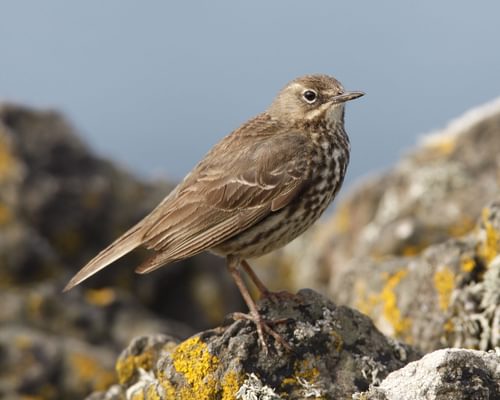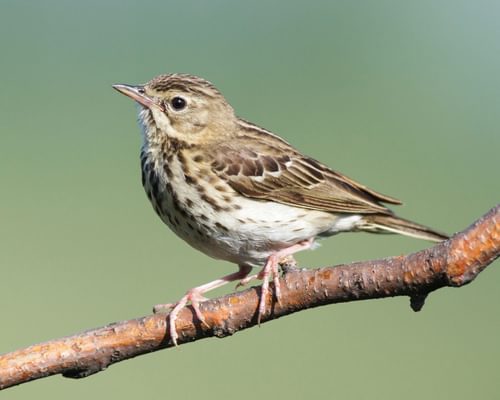Water Pipit
Anthus spinoletta
Visual Identification
Appearance
The Water Pipit is a small, slender passerine with a streaked brown upperpart and pale underparts. It has a long tail, thin bill, and distinctive white outer tail feathers visible in flight.
During the breeding season, adults develop a pinkish wash on the breast and a pale supercilium. Non-breeding plumage is duller, with heavier streaking on the underparts.
Females are similar to males, with no significant differences in plumage or size. However, females sometimes have a greyer head. Juveniles resemble non-breeding adults but are darker, and their plumage is distinctly more streaked, particularly on the underparts.
Size
Length
15cm to 17cm
Wingspan
25cm to 28cm
Weight
18g to 24g
Colours
Males and females have similar plumage
Primary Colour
Brown Grey
Secondary Colour
White Buff
Beak Colour
Brown
Leg Colour
Brown
Habitat and Distribution
Habitats
Woodland
Garden
Wetland
Coastal
Urban
Farmland
Grassland
Desert
Tundra
Rainforest
Mountain
Savanna
Distribution
Water Pipits breed in high-altitude meadows and rocky areas of mountain ranges across Europe and Asia. They prefer open, moist habitats near streams or snowmelt areas.
In winter, they migrate to lower elevations, frequenting coastal marshes, wet grasslands, and agricultural fields. In the UK, they are winter visitors found along the southern and eastern coasts.
Common UK locations include Norfolk, Cornwall, Dorset, Merseyside, Cambridgeshire, Suffolk, Surrey and Lincolnshire among other places. Sighting is best between October and April.
Elevation Range
615 to 3,200 meters
Climate zones
Temperate, Subarctic
Distribution Map
This map gives you a rough idea of where you might spot a Water Pipit. The coloured areas show countries where these birds have been seen.
A few things to keep in mind:
- Birds might not be everywhere in the coloured areas, for example, they may be present around the coast of that country
- Where birds live can change with seasons and available food
- This map is quite simple - it doesn't show exact locations
We're working on making our maps even better! Soon, we hope to show you:
- More detailed maps for bigger countries, including state and region
- How birds move around during different seasons
Distribution by Region
Behaviour and Ecology
Bird Attributes
This feature is in beta. We'd love your feedback to improve it!
Share your thoughtsBird Attributes Explained
Our bird attributes system rates various aspects of a bird's capabilities on a scale of 0-100, based on data from field observations, scientific studies, and expert knowledge.
Attribute Categories:
- Agility: Manoeuvrability, speed, and grace in flight or movement.
- Strength: Physical power, often correlating with size and hunting abilities.
- Adaptability: Ability to thrive in various environments or changing conditions.
- Aggressiveness: Territorial behaviour and assertiveness, particularly during breeding seasons.
- Endurance: Stamina, often seen in migration patterns or foraging behaviours.
Understanding the Ratings:
- 0-20: Very Low
- 21-40: Low
- 41-60: Average
- 61-80: High
- 81-100: Very High
Remember, these attributes are relative to other bird species and don't necessarily indicate superiority.
Hover over the icon next to each attribute for more information.
Tap the icon next to each attribute for more information.
Agility
Reflects the bird's manoeuvrability, speed, and grace in flight or movement.
The Water Pipit demonstrates considerable agility, as evidenced by its ability to walk and run swiftly on the ground, perform aerial display flights, and navigate diverse habitats from alpine meadows to coastal marshes. Its slender build and long tail contribute to its nimbleness.
Strength
Indicates the bird's physical power, often correlating with size and hunting abilities.
As a small passerine weighing between 18-24 grams, the Water Pipit has limited strength compared to larger birds. However, it possesses sufficient strength for its size to perform display flights and migrate between breeding and wintering grounds.
Adaptability
Represents the bird's ability to thrive in various environments or changing conditions.
Water Pipits show remarkable adaptability, thriving in environments ranging from 615 to 3,200 metres elevation. Their ability to adjust to both high-altitude breeding grounds and lowland wintering areas, coupled with their diverse diet, indicates high adaptability.
Aggressiveness
Measures the bird's territorial behaviour and assertiveness, particularly during breeding seasons.
While not particularly aggressive, male Water Pipits do establish and defend territories during breeding season. Their aerial displays and songs suggest a moderate level of assertiveness in mate attraction and territory defence, but they are not known for exceptional aggression.
Endurance
Reflects the bird's stamina, often seen in migration patterns or foraging behaviours.
The Water Pipit's endurance is noteworthy, considering its migratory nature and ability to survive in harsh alpine environments. Its capacity to perform aerial displays and undertake seasonal migrations between diverse habitats indicates good stamina for a bird of its size.
Diet
Water Pipits primarily feed on small invertebrates, including insects, spiders, and small molluscs. Crickets, grasshoppers, lacewings, cicadas, sawflies, moths, butterflies and caterpillars are common prey items. Snails, worms and millipedes are also eaten.
They forage on the ground, often near water edges, picking prey from vegetation or exposed soil. During winter, they may supplement their diet with some seeds, berries and algae.
Behaviour
Water Pipits are often seen walking or running on the ground, bobbing their tails as they move. They forage by picking insects from the ground or low vegetation.
During the breeding season, males perform aerial display flights, singing as they ascend and descend.
Vocalisation
The Water Pipit's song is a series of high-pitched, tinkling notes, often delivered during its display flight. The typical call is a sharp, thin 'tsip' or 'tseep', frequently given in flight.
During the breeding season, males sing more elaborate sequences from perches or in the air.
Nesting & Breeding
Breeding season for Water Pipits typically begins in late spring. Males establish territories and attract females with aerial display flights and songs.
Nests are built on the ground, often concealed under vegetation or rock overhangs. The cup-shaped nest is constructed of grass and lined with finer materials. Females lay 4-6 eggs, which are greyish-white with dark speckles.
Incubation lasts about 14 days, primarily by the female. Both parents feed the nestlings, which fledge after approximately 14-15 days.
Conservation and Status
Global Conservation Status
While the Water Pipit is currently listed as Least Concern, it faces threats from habitat loss due to changes in agricultural practices and climate change.
Conservation efforts focus on preserving high-altitude breeding habitats and protecting wintering grounds in wetland areas.
Birdwatching Tips
- Look for Water Pipits near streams, wet meadows, and alpine grasslands
- Listen for their high-pitched 'tsip' call as they fly
- Observe their characteristic tail-wagging behaviour when perched
- In the UK, watch for them in coastal areas during the winter months
Additional Information
Quick Facts
Other names:
Eurasian Water Pipit
Family:
MotacillidaeAverage Lifespan
2 to 5 years
Max Lifespan
4.9 years [4]
Predators
Main predators of Water Pipits include small raptors such as Merlins and Sparrowhawks, as well as ground predators like foxes and weasels that may raid nests.
Did You Know?
- Water Pipits can survive in high-altitude environments up to 3,000 meters above sea level.
- They are one of the few bird species that breed in both the Alps and the Himalayas.
- Despite their name, Water Pipits are not strictly tied to aquatic habitats and can be found in dry alpine meadows.
Similar Birds
References
- 1 2 3
website: BirdLife International. 2018. Anthus spinoletta. The IUCN Red List of Threatened Species 2018: e.T22718571A131988012.
View source - 4
website, 2022: BTO Ringing Report
View source
Share Your Feedback
We value your opinion! Let us know what you think about this bird page.

